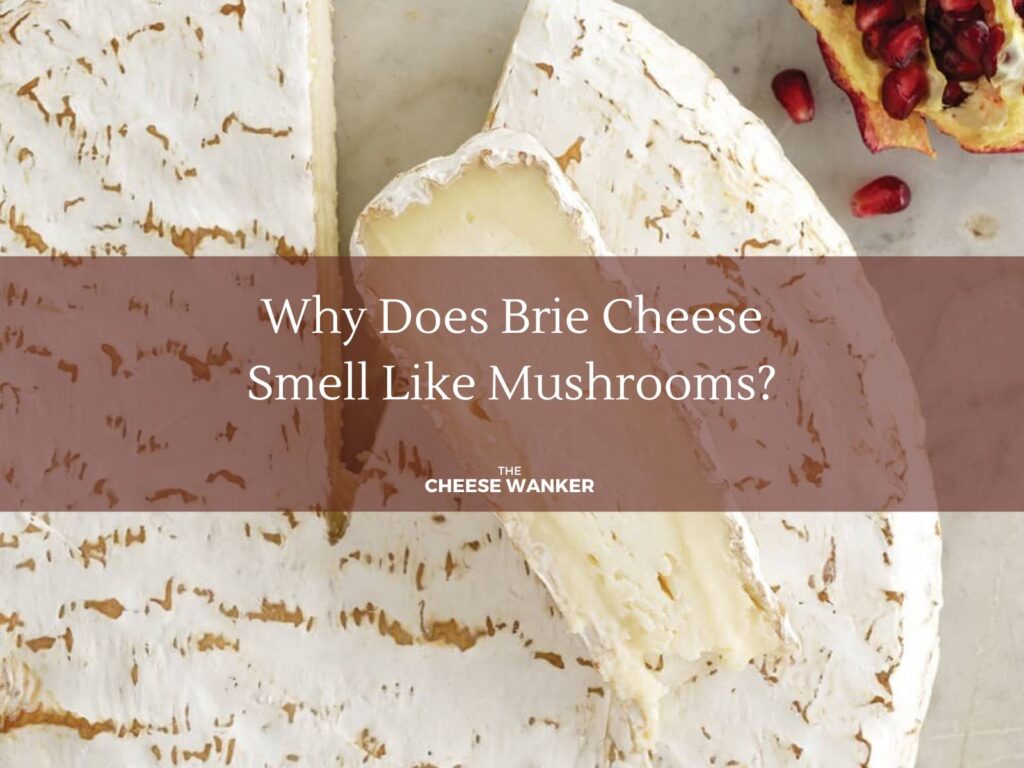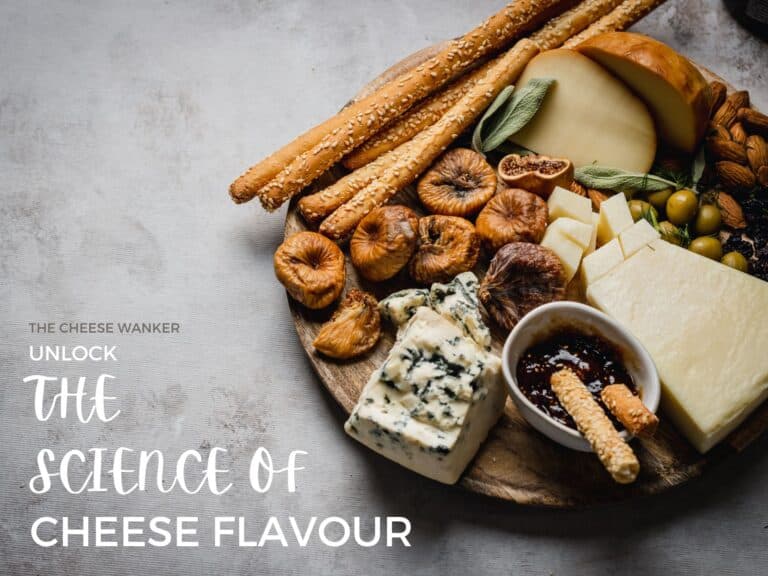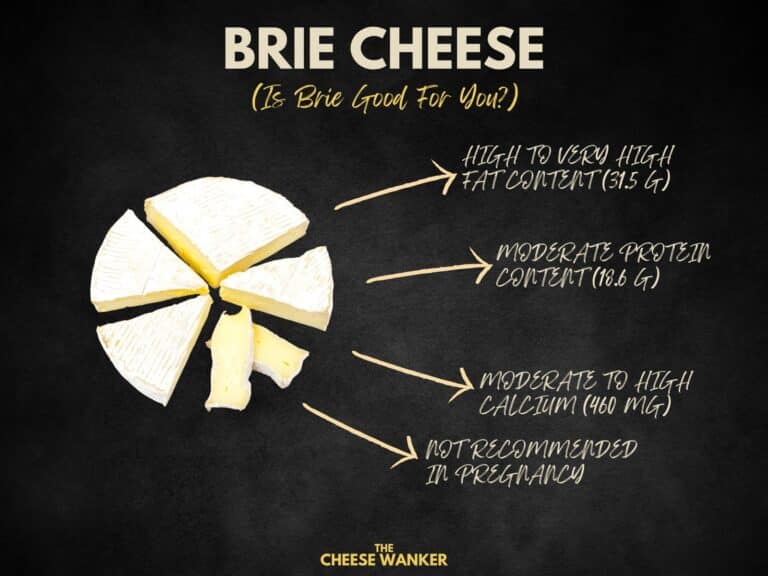In the world of gastronomy, few cheeses captivate the senses quite like Brie. Its alluring aroma, reminiscent of earthy mushrooms, has puzzled and intrigued cheese enthusiasts for generations. Join us as we embark on a journey to understand why Brie cheese smells like mushrooms.

SEE ALSO: Are Brie & Camembert actually different? →
What is Brie?
Brie is a soft and sumptuous cheese with a history that stretches back centuries. This velvety creation has an elegant appearance, boasting a pale-yellow paste that contrasts beautifully with its snowy white rind.
Actually, Brie originates from the Île-de-France region in northern France. Specifically, it takes its name from the historic French province of Brie, which encompasses parts of modern-day Seine-et-Marne and surrounding areas.
The cheese has a long and storied history that dates back centuries, with its origins closely tied to the region’s agricultural practices and culinary traditions. Brie has since become a globally recognised and beloved cheese, cherished for its delicate flavours, creamy texture and signature aroma.
What type of cheese is Brie?
Brie belongs to the family of soft white mould cheeses. Soft white mould cheeses, one of the eight types of cheese, boast a delicate exterior veiled in a snowy coat of moulds.
Some other examples of soft white mould cheeses are Camembert, Brillat-Savarin and Selles-sur-Cher.
Why does Brie smell like mushrooms?
Now that we’ve covered the basics, let’s explore the science behind why Brie smells like mushrooms.
Underneath the soft white mould rind lies a fascinating microbial tapestry, where beneficial moulds and bacteria collaborate to shape both the cheese’s distinct aroma and its evolving taste profile. The allure of soft white mould cheeses lies in their ability to capture the essence of their surroundings and the craftsmanship of their creators, resulting in a sensory experience that effortlessly marries tradition and innovation.
In the case of Brie, the mould is most often present on its rind is Penicillium camemberti.
Why does mould grow on the rind of Brie?
Penicillium camemberti thrives on the rind of Brie due to a combination of factors. This mould species is specially selected for its transformative qualities during the cheese-ripening process. As Brie matures, the controlled environment and carefully managed conditions encourage the growth of Penicillium camemberti on the rind.
This mould not only contributes to the distinctive white appearance of the rind but also plays a pivotal role in breaking down the cheese’s proteins and fats. In this symbiotic relationship, Penicillium camemberti helps create the velvety texture, creamy interior, and complex flavours that are characteristic of Brie cheese.
What happens when fat molecules are broken down?
One of the by-products of this “lipolysis” is a compound called 1-Octen-3-ol. 1-Octen-3-ol, also known as octenol, is a naturally occurring organic compound that belongs to the class of alcohols. It has a distinct mushroom-like, earthy and slightly woody aroma.
This compound is commonly found in various natural sources, including fruits, vegetables, and fungi.
Another fun fact is that the same white mould, and alcohol, can be found on a number of dried Italian salamis and French saucisson secs. And, as with the cheese, they create a mushroomy, earthy aroma by breaking down the fat in the meat.
What else does Brie smell like?
While the mushroom aroma is certainly a star player, Brie’s journey through ageing yields a symphony of other aromatic notes.
The aroma of Brie cheese is an intriguing and nuanced experience that evokes images of an enchanting culinary landscape. It carries a delicate, earthy quality reminiscent of freshly turned soil after a gentle rain, conjuring the essence of a serene woodland glade. This earthiness intertwines with a luscious creaminess, creating a harmonious balance that’s both alluring and comforting.
Without a doubt, the enchanting aroma of Brie is both delicate and inviting, offering a tantalising preview of the cheese’s complex flavours that await within its velvety interior. Just as the aroma of Brie draws you in, its taste promises a symphony of buttery, tangy, and nutty notes, making every indulgent bite a sensory journey through the lush landscapes of flavour.
Is it safe to eat Brie’s white mould?
For those new to the world of Brie, a common concern might be the white mould rind itself. Rest assured, this natural rind is entirely safe to eat and contributes to the cheese’s unique character. When crafted and stored correctly, Brie is not only delicious but also perfectly safe for consumption.
How to serve Brie at its best
To fully appreciate Brie’s multi-faceted flavours and aromas, it’s best enjoyed at room temperature. Allow the cheese to breathe and reach its full potential before indulging.
If you’ve brought home a whole wheel of Brie, you will want to wait until it is close to (or even past) its “Best Before Date”. Want to know why? Our complete post here will explain when soft cheeses are at their best!
Pair with an array of complementary accompaniments such as ripe fruits, toasted nuts, or crusty baguette to elevate your tasting experience.
Conclusion: Brie’s aroma is an organic chemistry thing
In conclusion, the reason why Brie smells like mushrooms is a complex interplay between microbial communities, enzymatic processes and unique ageing conditions.
As the cheese matures, the breakdown of proteins and fats by various microorganisms and enzymes leads to the release of volatile compounds, some of which share aromatic similarities with mushrooms. The distinct earthy, mushroom-like fragrance is a testament to the artisanal craftsmanship and the science behind the cheesemaking process.
Now, tell me, what’s your favourite aroma in cheese? Are you more dirty socks in Epoisses? Or mushrooms and damp forest floor in Brie de Meaux? Drop me a comment below.



